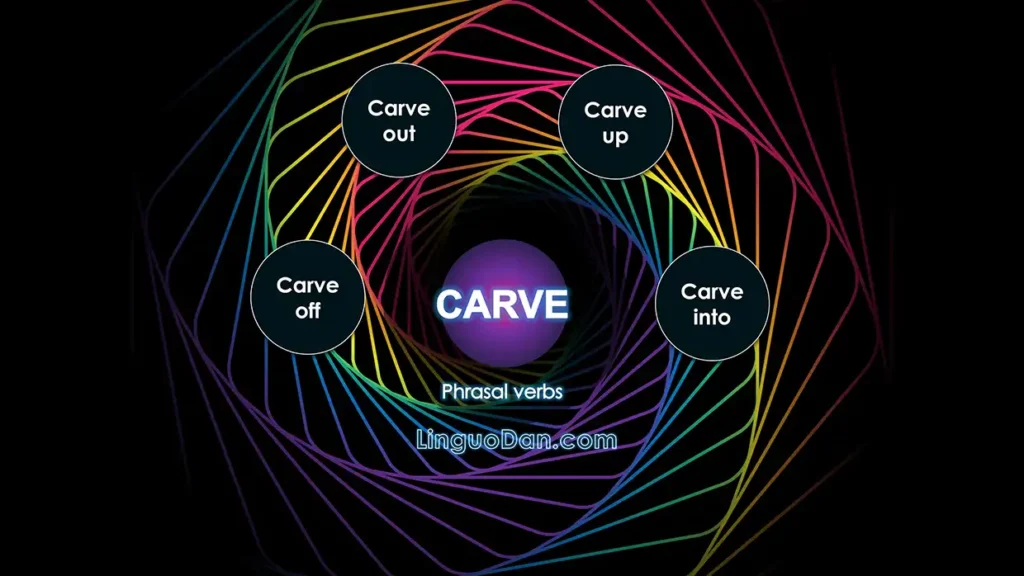Phrasal verbs with “Carve” in English

Phrasal Verbs and Idioms with “Carve”: A Comprehensive Guide for English Learners
Phrasal verbs are an essential part of the English language, and they can be challenging for learners. In this guide, we’ll focus on the word “carve” and its use in phrasal verbs and idioms. This article will help you understand the various meanings of “carve,” show you how to use it in different contexts, and expand your vocabulary.
What Does “Carve” Mean?
“Carve” means to cut or shape something from a hard material, like wood or stone, using tools. It is a regular verb:
- Present Simple: carve
- Past Simple: carved
- Past Participle: carved
Examples:
- He carved a wooden statue.
- She is learning how to carve stone.
Phrasal Verbs with “Carve”
1. Carve out
Meaning:
- To create or achieve something through hard work.
- To cut something from a larger whole.
Examples:
- She managed to carve out a successful career in medicine.
- They carved out a path through the dense jungle.
Explanation: “Carve out” is used when someone works hard to create or achieve something meaningful.
2. Carve up
Meaning:
- To divide something into parts, often unfairly.
- To split something among several people or groups.
Examples:
- After the war, the victors carved up the conquered territory.
- The cake was carved up into eight equal pieces.
Explanation: “Carve up” can have a negative connotation, especially when referring to an unfair division.
3. Carve into
Meaning:
- To engrave or cut something into a surface.
- To begin reducing or using part of something.
Examples:
- He carved their initials into the tree trunk.
- Unexpected expenses carved into their savings.
Explanation: Used both in a literal sense (engraving) and a figurative sense (reducing something).
4. Carve off
Meaning:
- To separate or cut a part from a whole.
Examples:
- He carved off a piece of meat for his dog.
- The company plans to carve off its unprofitable divisions.
Explanation: Describes the process of removing a part from something larger.
5. Carve through
Meaning:
- To make a way through something, usually with effort.
Example:
- The hikers carved through the thick underbrush to reach the summit.
Explanation: Indicates the effort required to overcome obstacles.
6. Carve out of
Meaning:
- To create something by removing material from a larger piece.
Example:
- The sculptor carved a statue out of marble.
Explanation: Focuses on the material from which something is created.
Idioms and Phrases with “Carve”
Carve one’s own path
Meaning:
- To pursue your own course; to do something in your unique way.
Example:
- Instead of following in his father’s footsteps, he decided to carve his own path.
Explanation: This phrase emphasizes independence and self-determination.
Carved in stone
Meaning:
- Unchangeable; final and not subject to alteration.
Example:
- The schedule isn’t carved in stone; we can still make adjustments.
Explanation: Used to show that something is not final and can still be changed.
How to Effectively Learn Phrasal Verbs and Idioms with “Carve”
- Contextual Learning: Read texts or watch movies where these expressions are used. This helps you understand how they function in real situations.
- Practice in Speaking and Writing: Try using new expressions in your conversations or writing.
- Associations and Visualization: Connect each new word or phrase with an image or a personal experience.
- Repetition: Regularly review what you’ve learned to reinforce it in your memory.
Grammatical Features of “Carve”
- Regular Verb: “Carve” adds “-ed” in the past tense and past participle forms.
- Transitive Verb Usage: It requires a direct object.
- She carved the pumpkin.
- As Part of Phrasal Verbs: Combined with prepositions or adverbs to create new meanings.
Why Is It Important to Know Phrasal Verbs with “Carve”?
- Enhances Your Speech: Using phrasal verbs makes your language sound more natural and expressive.
- Understand Native Speakers: Native speakers frequently use phrasal verbs in everyday communication.
- Effective Communication: Knowing these expressions helps you convey your thoughts more precisely and avoid misunderstandings.
Tips for Memorization
- Keep a Vocabulary Journal: Write down new phrasal verbs and idioms along with examples.
- Engage in Language Games: Use crosswords, puzzles, or mobile apps to make learning fun.
- Communicate with Native Speakers: Practice with English-speaking friends or language partners online.
Phrasal verbs and idioms with “carve” can greatly enhance your command of the English language. Understanding the different meanings and contexts of these expressions will help you communicate more naturally and effectively.